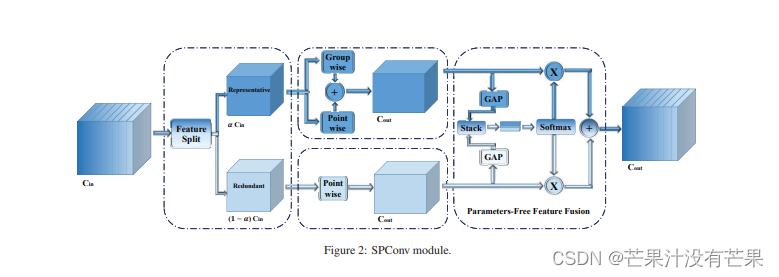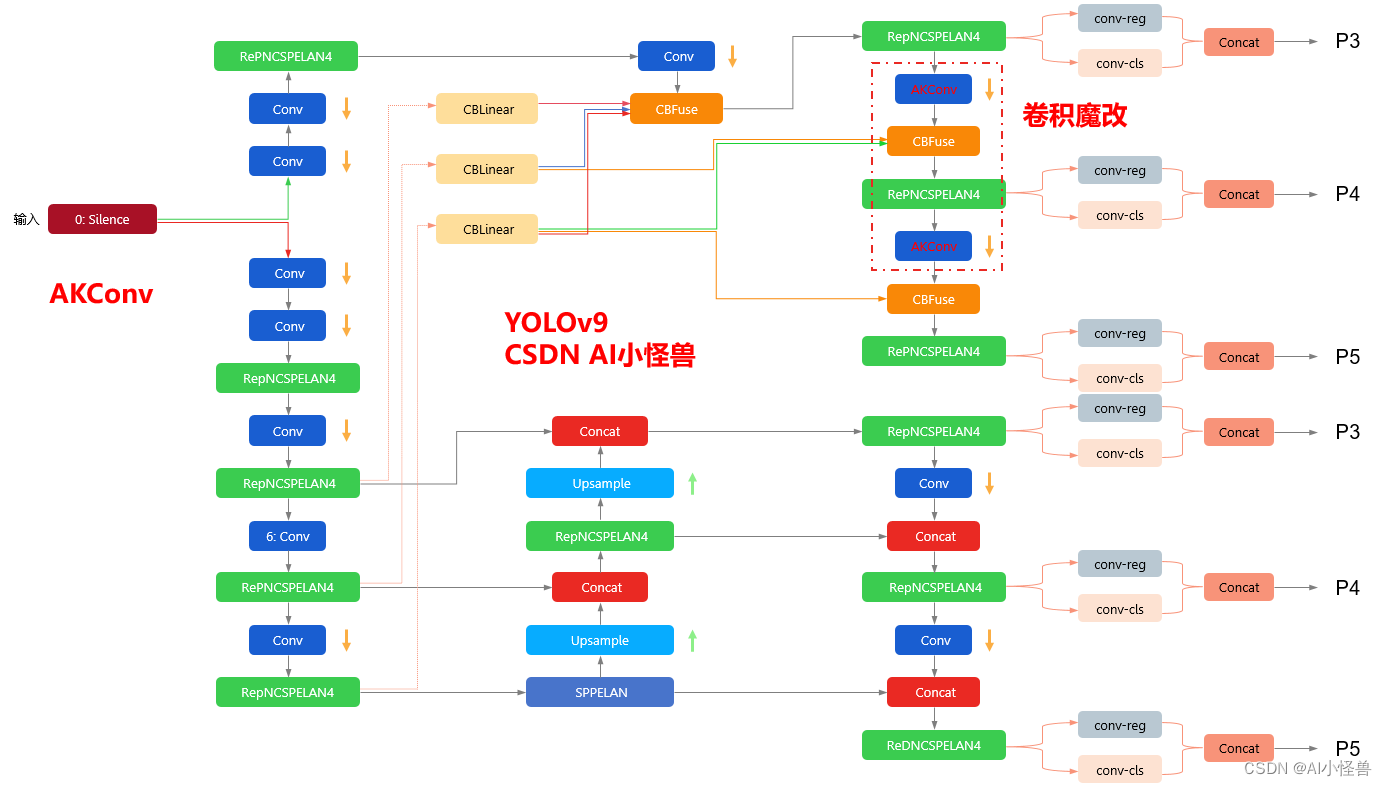一、导言
《DetectoRS: 使用递归特征金字塔和可切换空洞卷积进行物体检测》这篇文章提出了一种用于物体检测的新方法,结合了递归特征金字塔(Recursive Feature Pyramid,RFP)和可切换空洞卷积(Switchable Atrous Convolution,SAC)。以下是对该研究的优缺点分析:
优点:
机制灵感来源于人眼视觉系统:通过模仿人类视觉系统的反馈连接机制,文章中的设计在宏观上使用了递归特征金字塔,将额外的反馈连接从特征金字塔网络(FPN)引入到底部向上的主干层。这有助于增强对物体的识别能力。
改进的主干设计:在微观层面,可切换空洞卷积允许以不同的空洞率卷积特征,并使用开关函数来组合结果。这种设计可以适应不同场景下的视野需求,提高模型对大物体和遮挡物体的检测性能。
显著提升检测性能:结合这两种技术,DetectoRS 在COCO测试集上取得了非常优秀的检测、实例分割和全景分割性能,例如达到55.7%的边界框平均精度(box AP)和48.5%的掩模平均精度(mask AP),以及50.0%的全景质量分数(PQ)。
加速训练过程:根据实验结果,包含RFP和SAC的模型能够显著加速训练过程并收敛到更低的损失值。
灵活性与兼容性:SAC提供了一种机制,可以轻松地将预训练的标准卷积网络(如ImageNet预训练模型)转换为适用于特定任务的模型,而不需要从头开始训练整个网络。
公开代码:作者公开了代码,使得其他研究人员可以复现结果并在此基础上进行进一步的研究和改进。
缺点:
计算资源需求:虽然DetectoRS提供了卓越的性能,但增加的递归和多尺度处理可能需要更多的计算资源和更长的训练时间,这可能限制了其在资源受限环境中的应用。
模型复杂度:由于模型引入了递归和可切换的组件,模型的复杂度有所增加,这可能影响模型的实时性和部署成本。
泛化能力待验证:尽管在COCO数据集上表现优秀,但DetectoRS在其他数据集或更广泛的应用场景下的泛化能力还有待进一步验证。
参数调整:为了实现最佳性能,可能需要对模型的多种参数进行精细调整,包括递归次数、空洞率等,这可能增加了模型调参的难度。
总的来说,《DetectoRS》在物体检测领域提出了创新的设计思路,显著提升了检测性能,但也存在一些潜在的局限性,如计算资源的需求和模型复杂度。

二、准备工作
首先在YOLOv5/v7的models文件夹下新建文件saconv.py,导入如下代码
from models.common import *
class ConvAWS2d(nn.Conv2d):
def __init__(self,
in_channels,
out_channels,
kernel_size,
stride=1,
padding=0,
dilation=1,
groups=1,
bias=True):
super().__init__(
in_channels,
out_channels,
kernel_size,
stride=stride,
padding=padding,
dilation=dilation,
groups=groups,
bias=bias)
self.register_buffer('weight_gamma', torch.ones(self.out_channels, 1, 1, 1))
self.register_buffer('weight_beta', torch.zeros(self.out_channels, 1, 1, 1))
def _get_weight(self, weight):
weight_mean = weight.mean(dim=1, keepdim=True).mean(dim=2,
keepdim=True).mean(dim=3, keepdim=True)
weight = weight - weight_mean
std = torch.sqrt(weight.view(weight.size(0), -1).var(dim=1) + 1e-5).view(-1, 1, 1, 1)
weight = weight / std
weight = self.weight_gamma * weight + self.weight_beta
return weight
def forward(self, x):
weight = self._get_weight(self.weight)
return super()._conv_forward(x, weight, None)
def _load_from_state_dict(self, state_dict, prefix, local_metadata, strict,
missing_keys, unexpected_keys, error_msgs):
self.weight_gamma.data.fill_(-1)
super()._load_from_state_dict(state_dict, prefix, local_metadata, strict,
missing_keys, unexpected_keys, error_msgs)
if self.weight_gamma.data.mean() > 0:
return
weight = self.weight.data
weight_mean = weight.data.mean(dim=1, keepdim=True).mean(dim=2,
keepdim=True).mean(dim=3, keepdim=True)
self.weight_beta.data.copy_(weight_mean)
std = torch.sqrt(weight.view(weight.size(0), -1).var(dim=1) + 1e-5).view(-1, 1, 1, 1)
self.weight_gamma.data.copy_(std)
class SAConv2d(ConvAWS2d):
def __init__(self,
in_channels,
out_channels,
kernel_size,
s=1,
p=None,
g=1,
d=1,
act=True,
bias=True):
super().__init__(
in_channels,
out_channels,
kernel_size,
stride=s,
padding=autopad(kernel_size, p),
dilation=d,
groups=g,
bias=bias)
self.switch = torch.nn.Conv2d(
self.in_channels,
1,
kernel_size=1,
stride=s,
bias=True)
self.switch.weight.data.fill_(0)
self.switch.bias.data.fill_(1)
self.weight_diff = torch.nn.Parameter(torch.Tensor(self.weight.size()))
self.weight_diff.data.zero_()
self.pre_context = torch.nn.Conv2d(
self.in_channels,
self.in_channels,
kernel_size=1,
bias=True)
self.pre_context.weight.data.fill_(0)
self.pre_context.bias.data.fill_(0)
self.post_context = torch.nn.Conv2d(
self.out_channels,
self.out_channels,
kernel_size=1,
bias=True)
self.post_context.weight.data.fill_(0)
self.post_context.bias.data.fill_(0)
self.bn = nn.BatchNorm2d(out_channels)
self.act = nn.SiLU() if act is True else (act if isinstance(act, nn.Module) else nn.Identity())
def forward(self, x):
# pre-context
avg_x = torch.nn.functional.adaptive_avg_pool2d(x, output_size=1)
avg_x = self.pre_context(avg_x)
avg_x = avg_x.expand_as(x)
x = x + avg_x
# switch
avg_x = torch.nn.functional.pad(x, pad=(2, 2, 2, 2), mode="reflect")
avg_x = torch.nn.functional.avg_pool2d(avg_x, kernel_size=5, stride=1, padding=0)
switch = self.switch(avg_x)
# sac
weight = self._get_weight(self.weight)
out_s = super()._conv_forward(x, weight, None)
ori_p = self.padding
ori_d = self.dilation
self.padding = tuple(3 * p for p in self.padding)
self.dilation = tuple(3 * d for d in self.dilation)
weight = weight + self.weight_diff
out_l = super()._conv_forward(x, weight, None)
out = switch * out_s + (1 - switch) * out_l
self.padding = ori_p
self.dilation = ori_d
# post-context
avg_x = torch.nn.functional.adaptive_avg_pool2d(out, output_size=1)
avg_x = self.post_context(avg_x)
avg_x = avg_x.expand_as(out)
out = out + avg_x
return self.act(self.bn(out))其次在在YOLOv5/v7项目文件下的models/yolo.py中在文件首部添加代码
from models.saconv import SAConv2d并搜索def parse_model(d, ch)
定位到如下行添加以下代码
SAConv2d,

三、YOLOv7-tiny改进工作
完成二后,在YOLOv7项目文件下的models文件夹下创建新的文件yolov7-tiny-saconv.yaml,导入如下代码。
# parameters
nc: 80 # number of classes
depth_multiple: 1.0 # model depth multiple
width_multiple: 1.0 # layer channel multiple
# anchors
anchors:
- [10,13, 16,30, 33,23] # P3/8
- [30,61, 62,45, 59,119] # P4/16
- [116,90, 156,198, 373,326] # P5/32
# yolov7-tiny backbone
backbone:
# [from, number, module, args] c2, k=1, s=1, p=None, g=1, act=True
[[-1, 1, Conv, [32, 3, 2, None, 1, nn.LeakyReLU(0.1)]], # 0-P1/2
[-1, 1, Conv, [64, 3, 2, None, 1, nn.LeakyReLU(0.1)]], # 1-P2/4
[-1, 1, Conv, [32, 1, 1, None, 1, nn.LeakyReLU(0.1)]],
[-2, 1, Conv, [32, 1, 1, None, 1, nn.LeakyReLU(0.1)]],
[-1, 1, Conv, [32, 3, 1, None, 1, nn.LeakyReLU(0.1)]],
[-1, 1, Conv, [32, 3, 1, None, 1, nn.LeakyReLU(0.1)]],
[[-1, -2, -3, -4], 1, Concat, [1]],
[-1, 1, Conv, [64, 1, 1, None, 1, nn.LeakyReLU(0.1)]], # 7
[-1, 1, MP, []], # 8-P3/8
[-1, 1, Conv, [64, 1, 1, None, 1, nn.LeakyReLU(0.1)]],
[-2, 1, Conv, [64, 1, 1, None, 1, nn.LeakyReLU(0.1)]],
[-1, 1, Conv, [64, 3, 1, None, 1, nn.LeakyReLU(0.1)]],
[-1, 1, Conv, [64, 3, 1, None, 1, nn.LeakyReLU(0.1)]],
[[-1, -2, -3, -4], 1, Concat, [1]],
[-1, 1, Conv, [128, 1, 1, None, 1, nn.LeakyReLU(0.1)]], # 14
[-1, 1, MP, []], # 15-P4/16
[-1, 1, Conv, [128, 1, 1, None, 1, nn.LeakyReLU(0.1)]],
[-2, 1, Conv, [128, 1, 1, None, 1, nn.LeakyReLU(0.1)]],
[-1, 1, Conv, [128, 3, 1, None, 1, nn.LeakyReLU(0.1)]],
[-1, 1, Conv, [128, 3, 1, None, 1, nn.LeakyReLU(0.1)]],
[[-1, -2, -3, -4], 1, Concat, [1]],
[-1, 1, Conv, [256, 1, 1, None, 1, nn.LeakyReLU(0.1)]], # 21
[-1, 1, MP, []], # 22-P5/32
[-1, 1, Conv, [256, 1, 1, None, 1, nn.LeakyReLU(0.1)]],
[-2, 1, Conv, [256, 1, 1, None, 1, nn.LeakyReLU(0.1)]],
[-1, 1, Conv, [256, 3, 1, None, 1, nn.LeakyReLU(0.1)]],
[-1, 1, Conv, [256, 3, 1, None, 1, nn.LeakyReLU(0.1)]],
[[-1, -2, -3, -4], 1, Concat, [1]],
[-1, 1, Conv, [512, 1, 1, None, 1, nn.LeakyReLU(0.1)]], # 28
]
# yolov7-tiny head
head:
[[-1, 1, SPPELAN, [256, 128]], # 29
[-1, 1, Conv, [128, 1, 1, None, 1, nn.LeakyReLU(0.1)]],
[-1, 1, nn.Upsample, [None, 2, 'nearest']],
[21, 1, Conv, [128, 1, 1, None, 1, nn.LeakyReLU(0.1)]], # route backbone P4
[[-1, -2], 1, Concat, [1]],
[-1, 1, Conv, [64, 1, 1, None, 1, nn.LeakyReLU(0.1)]],
[-2, 1, Conv, [64, 1, 1, None, 1, nn.LeakyReLU(0.1)]],
[-1, 1, Conv, [64, 3, 1, None, 1, nn.LeakyReLU(0.1)]],
[-1, 1, Conv, [64, 3, 1, None, 1, nn.LeakyReLU(0.1)]],
[[-1, -2, -3, -4], 1, Concat, [1]],
[-1, 1, Conv, [128, 1, 1, None, 1, nn.LeakyReLU(0.1)]], # 39
[-1, 1, Conv, [64, 1, 1, None, 1, nn.LeakyReLU(0.1)]],
[-1, 1, nn.Upsample, [None, 2, 'nearest']],
[14, 1, Conv, [64, 1, 1, None, 1, nn.LeakyReLU(0.1)]], # route backbone P3
[[-1, -2], 1, Concat, [1]],
[-1, 1, Conv, [32, 1, 1, None, 1, nn.LeakyReLU(0.1)]],
[-2, 1, Conv, [32, 1, 1, None, 1, nn.LeakyReLU(0.1)]],
[-1, 1, Conv, [32, 3, 1, None, 1, nn.LeakyReLU(0.1)]],
[-1, 1, Conv, [32, 3, 1, None, 1, nn.LeakyReLU(0.1)]],
[[-1, -2, -3, -4], 1, Concat, [1]],
[-1, 1, Conv, [64, 1, 1, None, 1, nn.LeakyReLU(0.1)]], # 49
[-1, 1, Conv, [128, 3, 2, None, 1, nn.LeakyReLU(0.1)]],
[[-1, 39], 1, Concat, [1]],
[-1, 1, Conv, [64, 1, 1, None, 1, nn.LeakyReLU(0.1)]],
[-2, 1, Conv, [64, 1, 1, None, 1, nn.LeakyReLU(0.1)]],
[-1, 1, Conv, [64, 3, 1, None, 1, nn.LeakyReLU(0.1)]],
[-1, 1, Conv, [64, 3, 1, None, 1, nn.LeakyReLU(0.1)]],
[[-1, -2, -3, -4], 1, Concat, [1]],
[-1, 1, Conv, [128, 1, 1, None, 1, nn.LeakyReLU(0.1)]], # 57
[-1, 1, Conv, [256, 3, 2, None, 1, nn.LeakyReLU(0.1)]],
[[-1, 29], 1, Concat, [1]],
[-1, 1, Conv, [128, 1, 1, None, 1, nn.LeakyReLU(0.1)]],
[-2, 1, Conv, [128, 1, 1, None, 1, nn.LeakyReLU(0.1)]],
[-1, 1, SAConv2d, [128, 3, 1, None, 1]],
[-1, 1, SAConv2d, [128, 3, 1, None, 1]],
[[-1, -2, -3, -4], 1, Concat, [1]],
[-1, 1, Conv, [256, 1, 1, None, 1, nn.LeakyReLU(0.1)]], # 65
[49, 1, Conv, [128, 3, 1, None, 1, nn.LeakyReLU(0.1)]],
[57, 1, Conv, [256, 3, 1, None, 1, nn.LeakyReLU(0.1)]],
[65, 1, Conv, [512, 3, 1, None, 1, nn.LeakyReLU(0.1)]],
[[66, 67, 68], 1, IDetect, [nc, anchors]], # Detect(P3, P4, P5)
]
from n params module arguments
0 -1 1 928 models.common.Conv [3, 32, 3, 2, None, 1, LeakyReLU(negative_slope=0.1)]
1 -1 1 18560 models.common.Conv [32, 64, 3, 2, None, 1, LeakyReLU(negative_slope=0.1)]
2 -1 1 2112 models.common.Conv [64, 32, 1, 1, None, 1, LeakyReLU(negative_slope=0.1)]
3 -2 1 2112 models.common.Conv [64, 32, 1, 1, None, 1, LeakyReLU(negative_slope=0.1)]
4 -1 1 9280 models.common.Conv [32, 32, 3, 1, None, 1, LeakyReLU(negative_slope=0.1)]
5 -1 1 9280 models.common.Conv [32, 32, 3, 1, None, 1, LeakyReLU(negative_slope=0.1)]
6 [-1, -2, -3, -4] 1 0 models.common.Concat [1]
7 -1 1 8320 models.common.Conv [128, 64, 1, 1, None, 1, LeakyReLU(negative_slope=0.1)]
8 -1 1 0 models.common.MP []
9 -1 1 4224 models.common.Conv [64, 64, 1, 1, None, 1, LeakyReLU(negative_slope=0.1)]
10 -2 1 4224 models.common.Conv [64, 64, 1, 1, None, 1, LeakyReLU(negative_slope=0.1)]
11 -1 1 36992 models.common.Conv [64, 64, 3, 1, None, 1, LeakyReLU(negative_slope=0.1)]
12 -1 1 36992 models.common.Conv [64, 64, 3, 1, None, 1, LeakyReLU(negative_slope=0.1)]
13 [-1, -2, -3, -4] 1 0 models.common.Concat [1]
14 -1 1 33024 models.common.Conv [256, 128, 1, 1, None, 1, LeakyReLU(negative_slope=0.1)]
15 -1 1 0 models.common.MP []
16 -1 1 16640 models.common.Conv [128, 128, 1, 1, None, 1, LeakyReLU(negative_slope=0.1)]
17 -2 1 16640 models.common.Conv [128, 128, 1, 1, None, 1, LeakyReLU(negative_slope=0.1)]
18 -1 1 147712 models.common.Conv [128, 128, 3, 1, None, 1, LeakyReLU(negative_slope=0.1)]
19 -1 1 147712 models.common.Conv [128, 128, 3, 1, None, 1, LeakyReLU(negative_slope=0.1)]
20 [-1, -2, -3, -4] 1 0 models.common.Concat [1]
21 -1 1 131584 models.common.Conv [512, 256, 1, 1, None, 1, LeakyReLU(negative_slope=0.1)]
22 -1 1 0 models.common.MP []
23 -1 1 66048 models.common.Conv [256, 256, 1, 1, None, 1, LeakyReLU(negative_slope=0.1)]
24 -2 1 66048 models.common.Conv [256, 256, 1, 1, None, 1, LeakyReLU(negative_slope=0.1)]
25 -1 1 590336 models.common.Conv [256, 256, 3, 1, None, 1, LeakyReLU(negative_slope=0.1)]
26 -1 1 590336 models.common.Conv [256, 256, 3, 1, None, 1, LeakyReLU(negative_slope=0.1)]
27 [-1, -2, -3, -4] 1 0 models.common.Concat [1]
28 -1 1 525312 models.common.Conv [1024, 512, 1, 1, None, 1, LeakyReLU(negative_slope=0.1)]
29 -1 1 197376 models.sppelan.SPPELAN [512, 256, 128]
30 -1 1 33024 models.common.Conv [256, 128, 1, 1, None, 1, LeakyReLU(negative_slope=0.1)]
31 -1 1 0 torch.nn.modules.upsampling.Upsample [None, 2, 'nearest']
32 21 1 33024 models.common.Conv [256, 128, 1, 1, None, 1, LeakyReLU(negative_slope=0.1)]
33 [-1, -2] 1 0 models.common.Concat [1]
34 -1 1 16512 models.common.Conv [256, 64, 1, 1, None, 1, LeakyReLU(negative_slope=0.1)]
35 -2 1 16512 models.common.Conv [256, 64, 1, 1, None, 1, LeakyReLU(negative_slope=0.1)]
36 -1 1 36992 models.common.Conv [64, 64, 3, 1, None, 1, LeakyReLU(negative_slope=0.1)]
37 -1 1 36992 models.common.Conv [64, 64, 3, 1, None, 1, LeakyReLU(negative_slope=0.1)]
38 [-1, -2, -3, -4] 1 0 models.common.Concat [1]
39 -1 1 33024 models.common.Conv [256, 128, 1, 1, None, 1, LeakyReLU(negative_slope=0.1)]
40 -1 1 8320 models.common.Conv [128, 64, 1, 1, None, 1, LeakyReLU(negative_slope=0.1)]
41 -1 1 0 torch.nn.modules.upsampling.Upsample [None, 2, 'nearest']
42 14 1 8320 models.common.Conv [128, 64, 1, 1, None, 1, LeakyReLU(negative_slope=0.1)]
43 [-1, -2] 1 0 models.common.Concat [1]
44 -1 1 4160 models.common.Conv [128, 32, 1, 1, None, 1, LeakyReLU(negative_slope=0.1)]
45 -2 1 4160 models.common.Conv [128, 32, 1, 1, None, 1, LeakyReLU(negative_slope=0.1)]
46 -1 1 9280 models.common.Conv [32, 32, 3, 1, None, 1, LeakyReLU(negative_slope=0.1)]
47 -1 1 9280 models.common.Conv [32, 32, 3, 1, None, 1, LeakyReLU(negative_slope=0.1)]
48 [-1, -2, -3, -4] 1 0 models.common.Concat [1]
49 -1 1 8320 models.common.Conv [128, 64, 1, 1, None, 1, LeakyReLU(negative_slope=0.1)]
50 -1 1 73984 models.common.Conv [64, 128, 3, 2, None, 1, LeakyReLU(negative_slope=0.1)]
51 [-1, 39] 1 0 models.common.Concat [1]
52 -1 1 16512 models.common.Conv [256, 64, 1, 1, None, 1, LeakyReLU(negative_slope=0.1)]
53 -2 1 16512 models.common.Conv [256, 64, 1, 1, None, 1, LeakyReLU(negative_slope=0.1)]
54 -1 1 36992 models.common.Conv [64, 64, 3, 1, None, 1, LeakyReLU(negative_slope=0.1)]
55 -1 1 36992 models.common.Conv [64, 64, 3, 1, None, 1, LeakyReLU(negative_slope=0.1)]
56 [-1, -2, -3, -4] 1 0 models.common.Concat [1]
57 -1 1 33024 models.common.Conv [256, 128, 1, 1, None, 1, LeakyReLU(negative_slope=0.1)]
58 -1 1 295424 models.common.Conv [128, 256, 3, 2, None, 1, LeakyReLU(negative_slope=0.1)]
59 [-1, 29] 1 0 models.common.Concat [1]
60 -1 1 65792 models.common.Conv [512, 128, 1, 1, None, 1, LeakyReLU(negative_slope=0.1)]
61 -2 1 65792 models.common.Conv [512, 128, 1, 1, None, 1, LeakyReLU(negative_slope=0.1)]
62 -1 1 328449 models.saconv.SAConv2d [128, 128, 3, 1]
63 -1 1 328449 models.saconv.SAConv2d [128, 128, 3, 1]
64 [-1, -2, -3, -4] 1 0 models.common.Concat [1]
65 -1 1 131584 models.common.Conv [512, 256, 1, 1, None, 1, LeakyReLU(negative_slope=0.1)]
66 49 1 73984 models.common.Conv [64, 128, 3, 1, None, 1, LeakyReLU(negative_slope=0.1)]
67 57 1 295424 models.common.Conv [128, 256, 3, 1, None, 1, LeakyReLU(negative_slope=0.1)]
68 65 1 1180672 models.common.Conv [256, 512, 3, 1, None, 1, LeakyReLU(negative_slope=0.1)]
69 [66, 67, 68] 1 17132 models.yolo.IDetect [1, [[10, 13, 16, 30, 33, 23], [30, 61, 62, 45, 59, 119], [116, 90, 156, 198, 373, 326]], [128, 256, 512]]
Model Summary: 257 layers, 5916430 parameters, 5916430 gradients
运行后若打印出如上文本代表改进成功。
四、YOLOv5s改进工作
完成二后,在YOLOv5项目文件下的models文件夹下创建新的文件yolov5s-saconv.yaml,导入如下代码。
# Parameters
nc: 1 # number of classes
depth_multiple: 0.33 # model depth multiple
width_multiple: 0.50 # layer channel multiple
anchors:
- [10,13, 16,30, 33,23] # P3/8
- [30,61, 62,45, 59,119] # P4/16
- [116,90, 156,198, 373,326] # P5/32
# YOLOv5 v6.0 backbone
backbone:
# [from, number, module, args]
[[-1, 1, Conv, [64, 6, 2, 2]], # 0-P1/2
[-1, 1, Conv, [128, 3, 2]], # 1-P2/4
[-1, 3, C3, [128]],
[-1, 1, Conv, [256, 3, 2]], # 3-P3/8
[-1, 6, C3, [256]],
[-1, 1, Conv, [512, 3, 2]], # 5-P4/16
[-1, 9, C3, [512]],
[-1, 1, Conv, [1024, 3, 2]], # 7-P5/32
[-1, 3, C3, [1024]],
[-1, 1, SPPF, [1024, 5]], # 9
]
# YOLOv5 v6.0 head
head:
[[-1, 1, Conv, [512, 1, 1]],
[-1, 1, nn.Upsample, [None, 2, 'nearest']],
[[-1, 6], 1, Concat, [1]], # cat backbone P4
[-1, 3, C3, [512, False]], # 13
[-1, 1, Conv, [256, 1, 1]],
[-1, 1, nn.Upsample, [None, 2, 'nearest']],
[[-1, 4], 1, Concat, [1]], # cat backbone P3
[-1, 3, C3, [256, False]], # 17 (P3/8-small)
[-1, 1, Conv, [256, 3, 2]],
[[-1, 14], 1, Concat, [1]], # cat head P4
[-1, 3, C3, [512, False]], # 20 (P4/16-medium)
[-1, 1, SAConv2d, [512, 3, 2]],
[[-1, 10], 1, Concat, [1]], # cat head P5
[-1, 3, C3, [1024, False]], # 23 (P5/32-large)
[[17, 20, 23], 1, Detect, [nc, anchors]], # Detect(P3, P4, P5)
]
from n params module arguments
0 -1 1 3520 models.common.Conv [3, 32, 6, 2, 2]
1 -1 1 18560 models.common.Conv [32, 64, 3, 2]
2 -1 1 18816 models.common.C3 [64, 64, 1]
3 -1 1 73984 models.common.Conv [64, 128, 3, 2]
4 -1 2 115712 models.common.C3 [128, 128, 2]
5 -1 1 295424 models.common.Conv [128, 256, 3, 2]
6 -1 3 625152 models.common.C3 [256, 256, 3]
7 -1 1 1180672 models.common.Conv [256, 512, 3, 2]
8 -1 1 1182720 models.common.C3 [512, 512, 1]
9 -1 1 656896 models.common.SPPF [512, 512, 5]
10 -1 1 131584 models.common.Conv [512, 256, 1, 1]
11 -1 1 0 torch.nn.modules.upsampling.Upsample [None, 2, 'nearest']
12 [-1, 6] 1 0 models.common.Concat [1]
13 -1 1 361984 models.common.C3 [512, 256, 1, False]
14 -1 1 33024 models.common.Conv [256, 128, 1, 1]
15 -1 1 0 torch.nn.modules.upsampling.Upsample [None, 2, 'nearest']
16 [-1, 4] 1 0 models.common.Concat [1]
17 -1 1 90880 models.common.C3 [256, 128, 1, False]
18 -1 1 147712 models.common.Conv [128, 128, 3, 2]
19 [-1, 14] 1 0 models.common.Concat [1]
20 -1 1 296448 models.common.C3 [256, 256, 1, False]
21 -1 1 1312257 models.saconv.SAConv2d [256, 256, 3, 2]
22 [-1, 10] 1 0 models.common.Concat [1]
23 -1 1 1182720 models.common.C3 [512, 512, 1, False]
24 [17, 20, 23] 1 16182 models.yolo.Detect [1, [[10, 13, 16, 30, 33, 23], [30, 61, 62, 45, 59, 119], [116, 90, 156, 198, 373, 326]], [128, 256, 512]]
Model Summary: 272 layers, 7744247 parameters, 7744247 gradients运行后若打印出如上文本代表改进成功。
五、YOLOv5n改进工作
完成二后,在YOLOv5项目文件下的models文件夹下创建新的文件yolov5n-saconv.yaml,导入如下代码。
# Parameters
nc: 1 # number of classes
depth_multiple: 0.33 # model depth multiple
width_multiple: 0.25 # layer channel multiple
anchors:
- [10,13, 16,30, 33,23] # P3/8
- [30,61, 62,45, 59,119] # P4/16
- [116,90, 156,198, 373,326] # P5/32
# YOLOv5 v6.0 backbone
backbone:
# [from, number, module, args]
[[-1, 1, Conv, [64, 6, 2, 2]], # 0-P1/2
[-1, 1, Conv, [128, 3, 2]], # 1-P2/4
[-1, 3, C3, [128]],
[-1, 1, Conv, [256, 3, 2]], # 3-P3/8
[-1, 6, C3, [256]],
[-1, 1, Conv, [512, 3, 2]], # 5-P4/16
[-1, 9, C3, [512]],
[-1, 1, Conv, [1024, 3, 2]], # 7-P5/32
[-1, 3, C3, [1024]],
[-1, 1, SPPF, [1024, 5]], # 9
]
# YOLOv5 v6.0 head
head:
[[-1, 1, Conv, [512, 1, 1]],
[-1, 1, nn.Upsample, [None, 2, 'nearest']],
[[-1, 6], 1, Concat, [1]], # cat backbone P4
[-1, 3, C3, [512, False]], # 13
[-1, 1, Conv, [256, 1, 1]],
[-1, 1, nn.Upsample, [None, 2, 'nearest']],
[[-1, 4], 1, Concat, [1]], # cat backbone P3
[-1, 3, C3, [256, False]], # 17 (P3/8-small)
[-1, 1, Conv, [256, 3, 2]],
[[-1, 14], 1, Concat, [1]], # cat head P4
[-1, 3, C3, [512, False]], # 20 (P4/16-medium)
[-1, 1, SAConv2d, [512, 3, 2]],
[[-1, 10], 1, Concat, [1]], # cat head P5
[-1, 3, C3, [1024, False]], # 23 (P5/32-large)
[[17, 20, 23], 1, Detect, [nc, anchors]], # Detect(P3, P4, P5)
]
from n params module arguments
0 -1 1 1760 models.common.Conv [3, 16, 6, 2, 2]
1 -1 1 4672 models.common.Conv [16, 32, 3, 2]
2 -1 1 4800 models.common.C3 [32, 32, 1]
3 -1 1 18560 models.common.Conv [32, 64, 3, 2]
4 -1 2 29184 models.common.C3 [64, 64, 2]
5 -1 1 73984 models.common.Conv [64, 128, 3, 2]
6 -1 3 156928 models.common.C3 [128, 128, 3]
7 -1 1 295424 models.common.Conv [128, 256, 3, 2]
8 -1 1 296448 models.common.C3 [256, 256, 1]
9 -1 1 164608 models.common.SPPF [256, 256, 5]
10 -1 1 33024 models.common.Conv [256, 128, 1, 1]
11 -1 1 0 torch.nn.modules.upsampling.Upsample [None, 2, 'nearest']
12 [-1, 6] 1 0 models.common.Concat [1]
13 -1 1 90880 models.common.C3 [256, 128, 1, False]
14 -1 1 8320 models.common.Conv [128, 64, 1, 1]
15 -1 1 0 torch.nn.modules.upsampling.Upsample [None, 2, 'nearest']
16 [-1, 4] 1 0 models.common.Concat [1]
17 -1 1 22912 models.common.C3 [128, 64, 1, False]
18 -1 1 36992 models.common.Conv [64, 64, 3, 2]
19 [-1, 14] 1 0 models.common.Concat [1]
20 -1 1 74496 models.common.C3 [128, 128, 1, False]
21 -1 1 328449 models.saconv.SAConv2d [128, 128, 3, 2]
22 [-1, 10] 1 0 models.common.Concat [1]
23 -1 1 296448 models.common.C3 [256, 256, 1, False]
24 [17, 20, 23] 1 8118 models.yolo.Detect [1, [[10, 13, 16, 30, 33, 23], [30, 61, 62, 45, 59, 119], [116, 90, 156, 198, 373, 326]], [64, 128, 256]]
Model Summary: 272 layers, 1946007 parameters, 1946007 gradients六、注意
SAConv最好用于替换3x3的卷积
另外,使用步骤二的代码进行YOLOv7-tiny改进SAConv的时候不要在yaml中加上激活函数,否则会报如下错误。
TypeError: conv2d() received an invalid combination of arguments - got (Tensor, Tensor, NoneType, tuple, tuple, tuple, int), but expected one of:
* (Tensor input, Tensor weight, Tensor bias, tuple of ints stride, tuple of ints padding, tuple of ints dilation, int groups)
didn't match because some of the arguments have invalid types: (Tensor, Tensor, !NoneType!, !tuple of (int, int)!, !tuple of (int, int)!, !tuple of (LeakyReLU, LeakyReLU)!, int)
* (Tensor input, Tensor weight, Tensor bias, tuple of ints stride, str padding, tuple of ints dilation, int groups)
didn't match because some of the arguments have invalid types: (Tensor, Tensor, !NoneType!, !tuple of (int, int)!, !tuple of (int, int)!, !tuple of (LeakyReLU, LeakyReLU)!, int)
运行后打印如上代码说明改进成功。
更多文章产出中,主打简洁和准确,欢迎关注我,共同探讨!









































